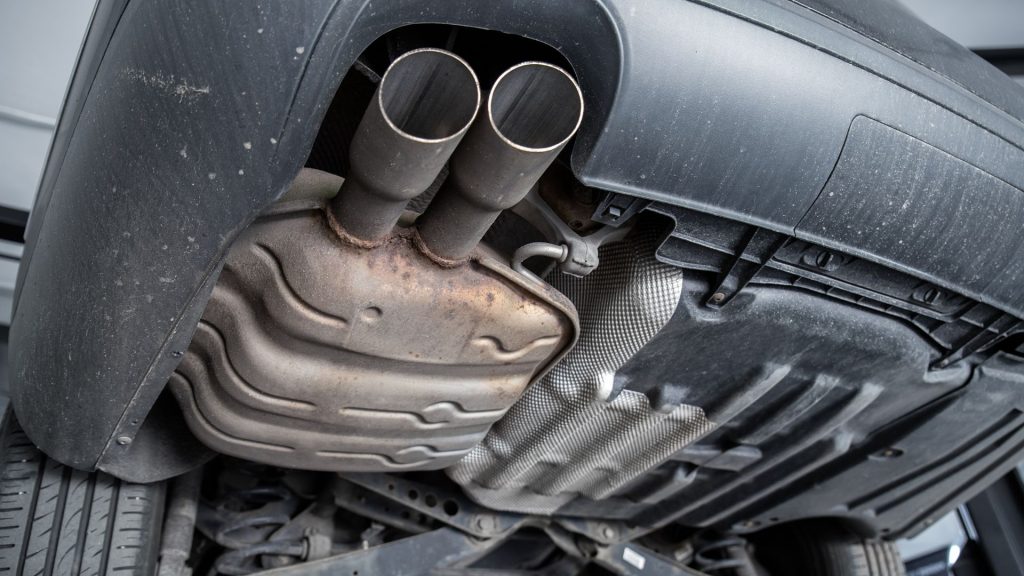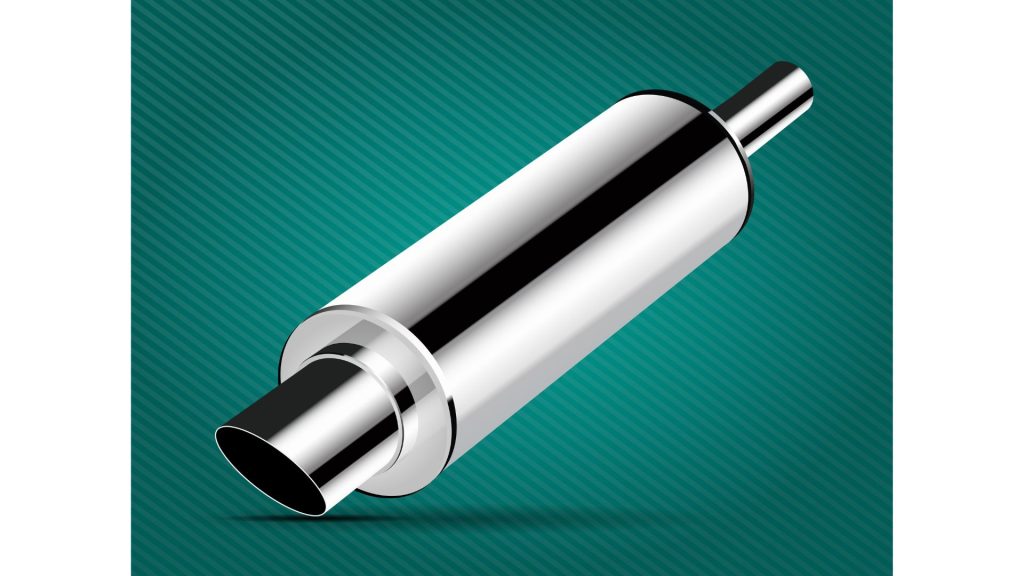| STATE | WILL MUFFLER DELETE PASS INSPECTION |
| NC | NO |
| NY | NO |
| PA | NO |
| TEXAS | NO |
| VA | NO |
| DELAWARE | NO |
| NJ | NO |
| LOUISIANA | NO |
| CA | NO |
| MASSACHUSETTS | NO |
While a muffler delete can pass an emissions test in these states, it won’t pass a general or noise inspection.
America’s interest in gas emissions is nothing new. According to this 1988 report from the Health Effects Institute (National Academy Press), the United States introduced the Clean Air Act in 1970 to protect the public from toxic emissions.
It is also worth highlighting this study in the Journal of Traffic And Transportation Engineering, which accused the transport sector of contributing a whopping 29 percent of greenhouse gas emissions.
Therefore, you can understand why so many states perform strict emissions inspections. But where does the muffler fit in this equation, and what happens when you remove it? Consider the following:
Understand What A Muffler Delete Is
You can’t understand a muffler delete without first understanding the function a muffler plays. Some laypeople think it works with the catalytic converter. However, this paper from Vaibhav D. Prajapati and Ankit J. Desai in the International Journal Of Engineering Research and Technology clarifies that a muffler reduces noise.
This is the component’s primary objective. Vehicles have various sources of noise, including pulleys, belts, valves, and other moving parts in the engine, the explosive process that occurs in the combustion chamber to generate the energy that moves your car, and the wheels as they roll along the road.
According to Forbes, the United States has nearly 300 million personal and commercial cars. Without mufflers, those cars would probably deafen passersby with their racket. Keep in mind that fast-moving vehicles can generate as much as 89 decibels, and from what the Centers for Disease Control and Prevention have seen, sustained noise that exceeds 70dB can harm your hearing.

Mufflers use tubes to interfere with the noise from the exhaust gases they receive. How-Stuff-Works has pictures showing the different parts of a muffler. A muffler delete is precisely what it sounds like.
It means raising the car and removing the muffler (replacing it with bypass tubing) or adding a straight pipe. A muffler delete eliminates the muffler’s primary function. Your vehicle will become louder.
The Reasons Why Someone Might Consider A Muffler Delete
If you don’t even know what the muffler looks like, let alone what it does for your car, it won’t occur to you to remove it. Other people remove these devices for the following reasons:
1). Noise
A muffler delete will make your vehicle louder; some people want that noise. They want to hear their automobile growl. It fills them with an indescribable thrill, especially drivers with a sporty car. Car enthusiasts get a rush a vehicle with a muffler won’t give them.
2). Convenience
A muffler delete is easy and quick. Consider this: you can get one for as little as $50, depending on your location, the mechanic’s rate, and the vehicle model. A muffler delete is a convenient method for making the car louder.
3). Increase Performance
A muffler delete can increase the horsepower in older vehicles because exhaust gases can leave the car at a quicker rate due to the absence of a muffler. The performance boost is more pronounced in older cars because their muffler chambers are more restrictive. They build backpressure.
You are unlikely to notice the increased performance in modern vehicles resulting from a muffler delete. The boost is too small to matter. Keep this in mind before committing to a muffler delete.
The Impact Of A Muffler Delete On Emissions And Whether It Will Cause The Car To Fail An Emissions Test
This is what every driver with a preference for noisy cars wants to know. To find that answer, you should start by understanding the workings of an automobile’s exhaust system:
- The exhaust system ejects the car’s toxic emissions.
- The emissions originate from the gas that explodes in the combustion chamber to produce energy.
- Once the detonation ends, the waste exits via the manifold. But rather than leaving the car directly, it flows through the catalytic converter, which uses precious metals to strip the toxic elements away.
- At this point, the emissions continue to the muffler, which uses tubes to dissipate the noise before sending the waste through the tailpipe into the environment.
As you’ve noticed, the muffler and the catalytic converter are separate components. Many laypeople confuse the two, which is why they ask the question above. Additionally, the muffler and exhaust pipe are not the same. The experts at Motor Hills have published pictures illustrating all three components.
Clearly, the muffler is part of the system that ejects emissions from the car. But it doesn’t process those emissions to make them less toxic. Therefore, removing the muffler won’t increase the volume of emissions your car generates.
But that doesn’t tell you whether or not a car can fail the emissions test if you remove the muffler. To answer that question, you need to know how an emissions test works in most settings:
- Laypeople expect experts to disassemble the car during a test. But they will start by looking at the engine computer. The Engine Control Module manages a significant portion of the vehicle’s functions, including the exhaust system. Therefore, inspectors will connect it to their computer to determine its efficiency.
- Inspectors will determine whether the ECM meets the standard associated with that particular vehicle. An ineffective ECM is problematic because it speaks volumes about the car’s overall condition. You can’t convince inspectors that a vehicle is safe to drive on a public road when the ECM is questionable.
- The gas analysis is the most crucial aspect of the emissions test. Inspectors will measure the oxygen, carbon dioxide, hydrocarbons, carbon monoxide, and nitrogen oxide.
You’ve probably noticed that an emissions test doesn’t mention the noise levels. Their main concern is the catalytic converter because it influences toxic emissions. Therefore, you risk failing the emissions test by changing or removing the catalytic converter.
The muffler has nothing to do with the emissions test. Inspectors won’t notice its absence while checking the engine computer or analyzing the exhaust system’s various gases. In other words, a muffler delete won’t cause the vehicle to fail its emissions test.
The Impact Of A Muffler Delete On Noise Levels And Whether It Will Cause The Car To Fail A Noise Test
This is your biggest challenge. Removing the muffler makes the car louder, which is problematic because mufflers exist to make cars quieter. Every state has laws regulating noise pollution, and removing the muffler breaks those laws.
Does that make a muffler delete illegal? Yes, it does. Your vehicle will pass the engine computer inspection and gas analysis during an emissions test. But it will fail a visual inspection if the experts choose to perform one.
Regulations usually encourage inspectors to perform visual inspections of every car to confirm the presence of a catalytic converter, but most of them skip this stage. If you pass the regular test without rousing suspicion, you can drive away before anyone asks questions.
However, if they notice anything unusual, a visual inspection will net you a fine. But what if you escape the emissions test without rousing suspicion? You’re not out of the woods yet.
Again, cars without mufflers are loud. Sooner or later, a traffic cop will stop you for noise pollution. Expect a fine for the excessive noise. What if you can keep the vehicle’s noise below the state’s recommended threshold?
Any traffic officer that inspects the vehicle and discovers the missing muffler will still fine you because removing the muffler is illegal.
The Potential Consequences Of Driving With A Muffler Delete
Removing the muffler is illegal in every state. However, you should check your laws to determine the exact requirements you must meet and the consequences you will face. Most states will demand the following:
- You must install a muffler on every car you intend to drive on a public road.
- You cannot cut the exhaust pipe off to prevent it from reaching the muffler.
- You cannot add openings in the exhaust pipe that bypass the muffler’s functions.
- Technically, you can overcome a muffler’s performance limitations by installing an after-market muffler that overcomes those weaknesses. However, such modifications are illegal if they increase the vehicle’s noise levels beyond a specific threshold. Traffic officers will fine you for noise pollution.
- Mufflers that allow the vehicle to release excess fumes into the atmosphere will also earn you a fine.
The penalties will vary. But the experts at drivinglaws.org expect the fines to range between $25 – $500. They won’t send you to prison or suspend your account. However, failing to fix the muffler issue will increase your fines.
If that isn’t enough to dissuade you from performing a muffler delete, consider the impact of a ticket on your insurance. You don’t want the state to categorize your offense as a moving violation. Your insurance rates will increase. Regarding long-term consequences, you should consider the points a muffler delete fine will add to your license.
Keep in mind that most cops will only stop you if your vehicle’s noise is too loud. Otherwise, they have no reason to perform visual inspections on random cars. A muffler delete is not worth the hassle. Don’t remove the muffler unless you’re ready to carry the weight of the consequences.
Alternatives To Muffler Delete

You can get away with a muffler delete by moving to a state that doesn’t perform emissions tests. After all, unless your car is louder than the rules permit, traffic officers have no reason to visually inspect it. Your only concern is an inspector that chooses to finish the emissions test by checking for the catalytic converter.
If they discover the missing muffler, they will fine you. If you don’t want to move to a different state, you could install a cat-back exhaust which streamlines the journey exhaust gases must undertake to exit the automobile.
But the most prominent alternative is an adjustable muffler. As the name suggests, you can increase or decrease the muffler’s noise by loosening or tightening a screw. However, as was noted above, you won’t pass inspection if the muffler makes more noise than the state regulations permit. An adjustable muffler can still earn you a ticket.
While a muffler delete can pass an emissions test in these states, it won’t pass a general or noise inspection.

